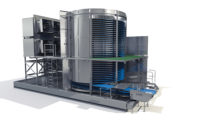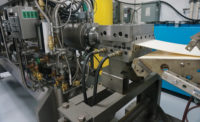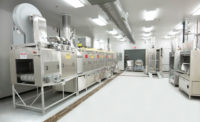Mixing systems help food producers whip up recipe for success

courtesy of Koenig Bakery Systems

courtesy of Bühler Inc.

courtesy of Koenig Bakery Systems

courtesy of Reading Bakery Systems

courtesy of Charles Ross & Son Company





The past few months have brought new production challenges for bakers and snack manufacturers. Outbreaks of avian influenza this spring resulted in the death of millions of domestic chickens and, consequently, egg shortages and escalating egg prices (see “Avian influenza’s impact on the bakery industry”). Many bakers and snack producers, therefore, turned to egg replacement systems to fill their ingredient gap and keep production costs in check.
Shortly thereafter, FDA announced it is giving food manufacturers three years to remove partially hydrogenated oils from their products or petition the agency to allow for specific uses of PHOs (see “FDA bans trans fats”). While some manufacturers have already started removing PHOs from their products, others are beginning to look for alternatives.
Meanwhile, consumer demand for products made with whole and ancient grains, gluten-free ingredients, beneficial inclusions (nuts, fruit and dark chocolate) and other healthy ingredients continues to grow. Some or all of these factors may impact bakers’ and snack manufacturers’ recipes, including how they mix ingredients and the equipment they use.
Addressing challenges
“Newer products certainly bring new challenges,” says Jim Warren, vice president, Exact Mixing, Reading Bakery Systems, Robesonia, PA. Mixing equipment must be designed for quick and easy cleaning, feature recipe-driven controls, offer both intense and gentle mixing, and allow for the addition of particulates later in the process, he explains.
Fragile ingredients—flaked, dried, dehydrated—also pose challenges for bakers and snack producers, says John Hunter, sales account manager, baking and ingredient handling, Bühler Inc., Plymouth, MN. He notes that taking such inclusions into consideration at the onset of production helps reduce overmixing and product deterioration.
While creating new products to meet consumer demand is a priority for bakers and snack producers, so is food safety, and the Food Safety Modernization Act (FSMA) has made it even more so. Mixing systems manufacturers are making sure their equipment enables their customers to comply with the new rules.
“Our mixer was redesigned significantly with food safety in mind,” says Hunter, adding that the changes were made in response to global food-safety legislation before the introduction of the FSMA. “For example, in old-style mixers, you change the tools on the end of the mixer by loosening a bolt. From a safety point of view, that means there’s another area with a cleaning issue.” He notes that his company now has a fully welded system that removes any crevices that are a concern from a food-safety perspective.
When it comes to equipment sanitation, employee safety and machine accessibility are also important. “I used to run a mixing plant, and one of the things that used to scare me was that somebody might be in a mixer without any safety systems to make sure it’s shut off,” Hunter explains. “So designing a mixer with good interfaces to make sure it’s turned off before somebody begins cleaning it is really important.”
Mixing systems are more than just mixers, though. “When we talk about a mixing system, we mean all the ingredient-handling systems that go with it and making sure they can do the job,” says Hunter. “Our mixing cycle is very short compared to some other types of mixers. You have to have an ingredient-handling system that’s designed appropriately to get the best out of a high-capacity system.”
Koenig Bakery Systems, Graz, Austria, will introduce the Twin Twist Mixer DW 240 H-S, a twin twist mixing machine with a hygienic, stainless steel design, next month at iba 2015 in Munich. Features include a framework and machine head with completely sealed weld construction; sealed coverings, switchboard doors and service doors made of stainless steel; a removable mixing bowl with dustproof cover; and a sealed touch panel. The model is also fully washable. It mixes dough rapidly with minimal dough warming, according to the company. It’s well-suited for making wheat, pastry, cookie and wafer dough.
Koenig’s Spiral Mixer comes with standard features that include stainless steel cladding, a stainless steel foot plate, two mixing speeds and a removable dough bowl. It’s also available with a stainless steel base frame. It, too, mixes dough rapidly with minimum warming and is suitable for wheat dough, wheat and rye dough, rye dough, and whole-wheat dough.
Both mixers are easy to clean and use, says Julia Kneidinger, marketing, Koenig Bakery Systems, and can be operated by one person due to their programmable settings.
Beyond food safety
Mixers with hygienic designs not only enable bakers and snack manufacturers to address food-safety concerns, they also can help food producers reduce their production costs, another important concern, according to Jim Warren, vice president, Exact Mixing, Reading Bakery Systems, Robesonia, PA. The company’s latest offering—the HDx or High Development continuous mixer—was developed over the past two years for products where the dough requires very high development, such hamburger buns, English muffins, breads and rolls. The model combines the company’s high-moisture mixer with a newly designed high-speed developer section.
In 2014, the company also introduced the Mx Series of mixers for the power and protein bar industry.
According to Warren, the company’s newest mixing equipment helps reduce manufacturers’ production costs by offering rapid changeover with minimum product loss, flexibility, a reliable design with few wear parts and reduced waste, energy costs and manpower costs.
Easy mixer cleanability is also important in terms of return on investment. “We’re designing a mixer that can get high throughput with good safety and good sanitation,” says Hunter. “One of the big things in terms of ROI is ease of cleaning. With most mixing systems, the amount of cleaning time you have is a significant portion of the time of the overall operation, so you have to know that you can get into it easily to clean it.”
Bakers and snack manufacturers often outgrow their existing mixing equipment by adding new product lines or increasing their customer base. When traditional mixers and blenders no longer serve a manufacturer’s production needs in an efficient manner, says Christine Banaszek, application engineer, Charles Ross & Son Company, Hauppauge, NY, it’s time to upgrade. “We offer a wide range of specialty mixing equipment that address issues such as scale-up, mixing intensity, batch-to-batch consistency, changeover and cleanability.”
Banaszek says the 3A-approved Inline High Shear Mixers help food manufacturers prepare smooth, lump-free sauces and fillings, among other products, in almost any size tank. The company’s Double Planetary Mixers equipped with unique helical blades, meanwhile, enable operators to upgrade from conventional single-planetary mixers for high-volume production of icing, dough, cheese products and other viscous applications. The company’s Multi-Shaft Mixers are designed for heat-sensitive products such as syrups, flavorings and candies. Ribbon and Paddle Blenders, on the other hand, can mix dry or wet recipes, from powdered spice blends, baking pre-mixes and trail mix snacks to fillings and other wet products.
“These mixing systems have been in use for decades,” says Banaszek, “but continue to evolve in many aspects, including automated controls, cleaner design, vacuum/pressure capability, shorter cycle time, etc. Because mixing is a very application-dependent operation, various mixer features are often tweaked and tailored to suit a specific product or range of products.”
Looking for a reprint of this article?
From high-res PDFs to custom plaques, order your copy today!











